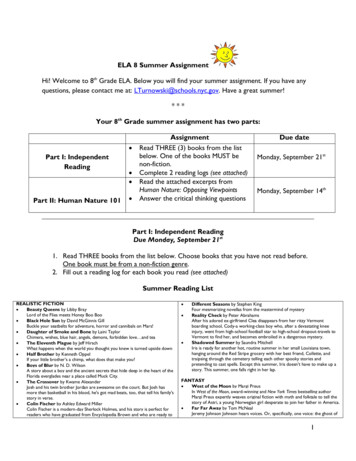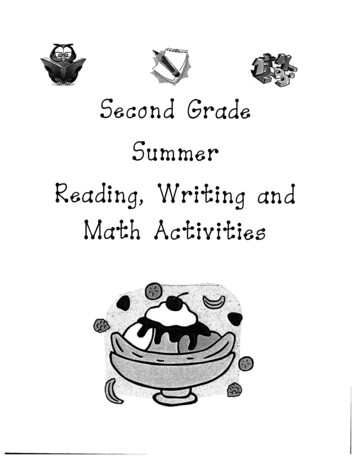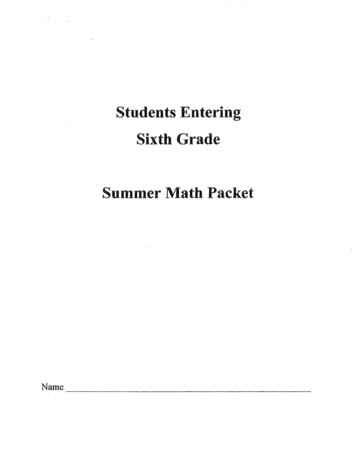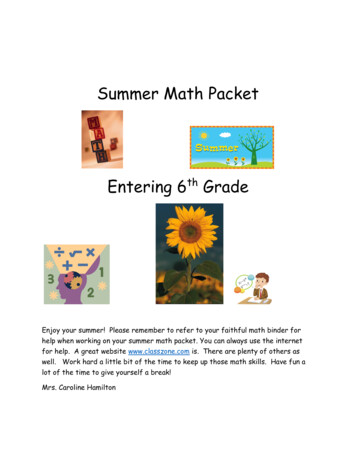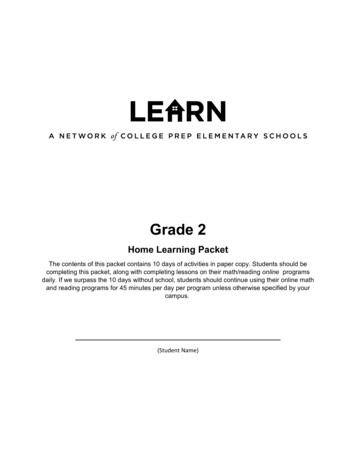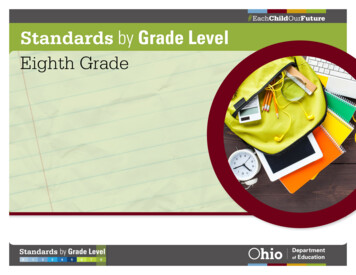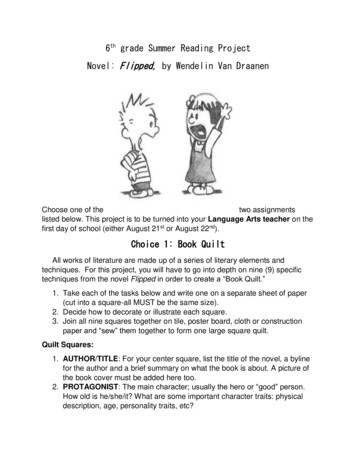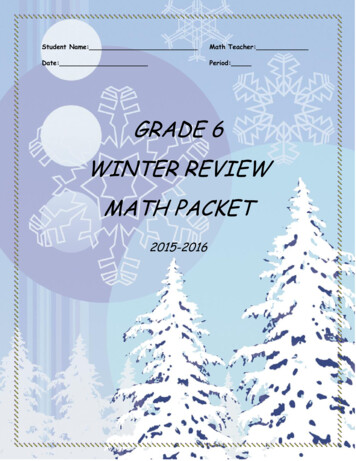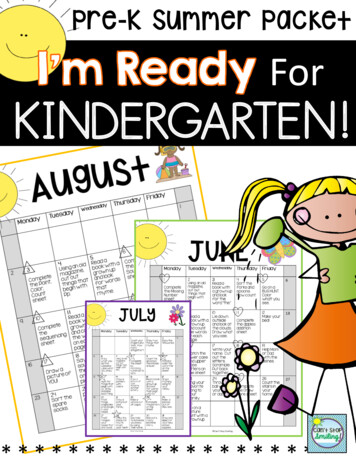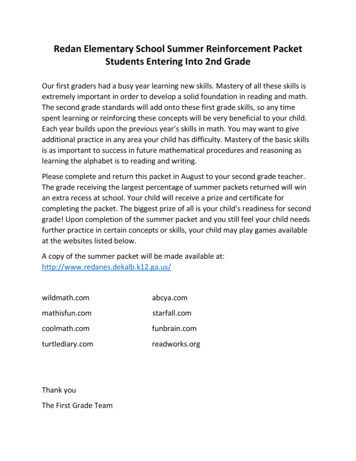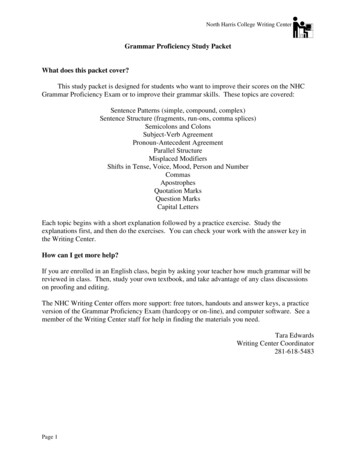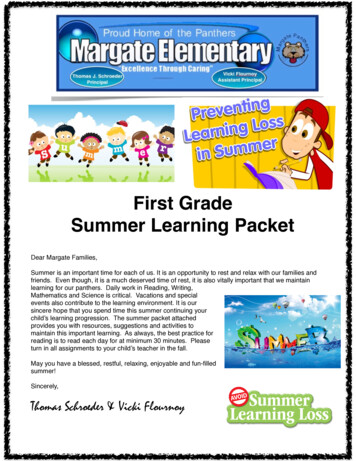
Transcription
First GradeSummer Learning PacketDear Margate Families,Summer is an important time for each of us. It is an opportunity to rest and relax with our families andfriends. Even though, it is a much deserved time of rest, it is also vitally important that we maintainlearning for our panthers. Daily work in Reading, Writing,Mathematics and Science is critical. Vacations and specialevents also contribute to the learning environment. It is oursincere hope that you spend time this summer continuing yourchild’s learning progression. The summer packet attachedprovides you with resources, suggestions and activities tomaintain this important learning. As always, the best practice forreading is to read each day for at minimum 30 minutes. Pleaseturn in all assignments to your child’s teacher in the fall.May you have a blessed, restful, relaxing, enjoyable and fun-filledsummer!Sincerely,Thomas Schroeder & Vicki Flournoy
DEAR FAMILY,As many of you are planning for your summer activities for your children, we want you toremember to encourage your children to read over the summer break! Reading for the sake of readingwill allow children to explore summer from home, on the road, on vacation or from their own backyard!Many children forget what they’ve learned during the school year while on summer break. This“achievement loss” is also known as the summer slide. Keeping your kids’ engaged with reading overthe summer months will help maintain their academic edge and reduce the summer slide. Children whodo not read over the summer could potentially lose more than 2 months of reading achievement andunfortunately summer reading loss is cumulative.Good News: Margate Elementary encourages reading over the summer by providing your childaccess to myON, an online personalized collection of more than 5,000 digital books that can be read oncomputers, laptops, and other devices anytime, anyplace. We hope you enjoy the 2016 SummerReading Program!Your children can now read with myON over the summer & choose the books that they areinterested in.www.myON.comSchool: Margate Elementary SchoolUsername: Student NumberPassword: Birthday mm/dd/yyyyHAPPY READING!Sincerely,Patti MooreLiteracy Coach
Dear Parents and Guardians,We are very excited to announce that our math program called Reflex willcontinue to be available for the summer. It is important to continue to work onmath during the summer months. Reflex is a game-based system that helps studentswith math fact fluency. Over the course of a student’s first few sessions, Reflexlearns which facts and fact families the student is not yet fluent with and it uses thisinformation when making instructional decisions for that student. This means thatstudents won’t spend time learning facts that they already know.Reflex is a web based program which means students can access the onlinesystem anywhere they have internet. It is also available for use on the ipad.www.reflexmath.comMy user name is: My password is:
Printable BookThe next four pages are a book about summer safety.To assemble the book, simply cut each page down thecenter, and staple the book together, with the first pageon the lefthand side as the cover. Your child should tryto read the book to you. At this age, children will enjoyreading a book over and over again, and it’s wonderfulpractice. Hang on to the book and have your childread it to you several times throughout the summer.
StayingSafe intheSummerStaying safe while youplay in the summer iseasy and fun!
When you playoutside, wear sunscreenon your skin.Wear sunglasses foryour eyes.
Wear light clothing if itis very hot out.Drink lots of water!
Only go in the pool ifan adult is with you.Stay safe and healthythis summer, andhave fun!
WritingThis summer, make sure to keep your child writing on a regular basis. If your child enjoysjournaling, you can make copies of the blank drawing and writing page and staple them to create adaily journal for your child. You can also make 3 copies of the page and staple them to create alittle book (you can certainly do more than 3 pages, but 3 encourages your child to write abeginning, middle, and end to the story). You might even take photographs of your child and gluethem down to each page, so your child can write a story about him/herself. If your child needs alittle inspiration to write, here are some prompts you can give him/her:At the beginning of the summer: “What would you like to do this summer? Make a list of all thefun things you want to do.”After going on a vacation, special trip, or visit to a park/museum/library: “What did we do firston our trip? Next? Last? Write about what happened in the beginning, middle, and end of ourtrip.”“Imagine you can go anywhere in the world or outer space this summer! Where would you like togo? Why? What would you do there?”“What is an animal you know a lot about? Write a book to teach me about what the animallooks like, what it eats, and where it lives.”
Letter Writing Practice (Part 1)Practice writing each pair of letters correctly on the dotted lines.Circle the capital and lowercase letters you wrote best on each line.AaBbCcDdEe
Letter Writing Practice (Part 2)Practice writing each pair of letters correctly on the dotted lines.Circle the capital and lowercase letters you wrote best on each line.FfGgHhIiJj
Letter Writing Practice (Part 3)Practice writing each pair of letters correctly on the dotted lines.Circle the capital and lowercase letters you wrote best on each line.KkLlMmNnOo
Letter Writing Practice (Part 4)Practice writing each pair of letters correctly on the dotted lines.Circle the capital and lowercase letters you wrote best on each line.PpQqRrSsTt
Letter Writing Practice (Part 5)Practice writing each pair of letters correctly on the dotted lines.Circle the capital and lowercase letters you wrote best on each line.UuVvWwXxYy
Letter Writing Practice (Part 6)Practice writing each pair of letters correctly on the dotted lines.Circle the capital and lowercase letters you wrote best on each line.ZzGood job! Now, practice writing your first and last name very neatly.
Number Word MatchDraw a line between the number word and its 45102103768
Color by Sight WordUse the key to read the sight words and color the picture.wentwhy bluewent yellowwould greenwhywouldwhywhywent
Color by Sight WordColor the ladybug’s face and spots black.Then, use thekey to read the sight words and color the rest of the picture.willstopwillthatwillwillwillwill greenthat brownstop red
Word SortWrite each word in the list under thepicture that has the same first letter.whatRead both lists.whosomewhensawwhereseesmall
Word SortWrite each word in the list under thepicture that has the same first letter.becanRead both lists.couldbeencan’tbothcarrybring
Math GamesThe next few pages contain number cards to cut. You and your child can play a variety of games with thesecards. Here are some ideas:1. Race Against the Clock - Time your child putting the cards in order from smallest to largest (or viceversa). Mix up the cards again, and have your child try to beat his or her record.2. Top-It (War) - Shuffle the cards, and deal them evenly between two players. To play, both players turnover the top card at the same time. The player with the largest number gets to take both cards and addthem to his/her stack. The player who eventually wins all the cards is the winner. You can also play this sothat the player with the smaller number wins, instead.3. Place Value Top-It (War) - Play the game as explained above, in #2, but use only the number cardsfrom 0-10 (make 2 copies of these). This time, instead of each player drawing one card, have them drawtwo and place them side by side. The first card drawn becomes the number in the tens place, and the secondcard drawn becomes the number in the ones place. The player with the larger number wins.4. Making Ten Memory - Print and cut two copies of the cards from 0-10. Then, place all cards facedown,as if to play Memory. Players take turns drawing two cards. If the two numbers add up to ten (i.e. 6 and4), the player keeps the cards as a match. If not, he/she puts the cards back. The player with the mostmatches at the end of the game is the winner.
01234567
89101112131415
1620171819
Number Writing Practice (Part 1)Practice writing each number correctly on the dotted lines.Circle the number you wrote best on each line.01234
Number Writing Practice (Part 2)Practice writing each number correctly on the dotted lines.Circle the number you wrote best on each line.56789
Counting Blocks (Part 1)Count the number of blocks you see. Write the number on the line.
Counting Blocks (Part 2)Count the number of blocks you see. Write the number on the line.
Counting Blocks (Part 3)Count the number of blocks you see. Write the number on the line.
Addition with Pictures (Sums to 5)3 2 1 3 2 2 4 1
Addition with Pictures (Sums to 10, Part 1)3 5 6 4 7 2 5 5
Addition with Pictures (Sums to 10, Part 2)0 9 3 7 4 4 2 8
Addition Practice (Part 1)1 2 4 1 2 1 3 1 1 1 1 3 2 2 0 0 0 2 3 2 2 3 0 1 1 0 5 0 3 2 2 2 1 4 2 0
Addition Practice (Part 2)5 2 7 3 6 2 7 1 4 4 3 5 2 8 10 0 0 5 9 1 6 3 1 8 4 0 5 4 7 2 5 5 3 4 9 0
Subtraction with Pictures (Part 1)X4-1 33 - 2 5 - 1 6 - 3
Subtraction with Pictures (Part 2)8 - 3 5 - 4 9 - 6 7 - 7
Subtraction with Pictures (Part 3)8 - 4 10 - 5 4 - 2 9 - 3
Subtraction Practice (Part 1)3 - 2 4 - 1 5 - 3 2 - 1 4 - 2 4 - 0 4 - 4 0 - 0 5 - 5 5 - 2 5 - 4 3 - 3 1 - 0 2 - 0 1 - 0 3 - 1 4 - 3 5 - 2
Subtraction Practice (Part 2)6 - 2 7 - 3 5 - 2 7 - 1 6 - 4 6 - 5 8 - 8 5 - 4 7 - 7 6 - 1 8 - 3 8 - 6 7 - 5 7 - 4 5 - 3 8 - 0 6 - 3 6 - 0
ShapesWrite the name of each shape. Then, write how many sides it has.sidessidessides
ShapesWrite the name of each shape. Then, write how many sides it has.sidessidessides
Counting by TensCount and write the groups of ten.
Project #1Domain: Counting and Cardinality (CC)K.CC.1 Count to 100 by ones and by tens.K.CC.3 Write numbers from 0‐20. Represent a number of objects with a written numeral 0‐20 (with 0representing a count of no objects).Directions:Fill in the missing numbers in the chart below.11124135615891018Next, make a collection of 20 of something you have around your house. It could be Cheerios, blocks, orhair clips! It is your choice!Now, write the numeral in the box next the items below.Example:3Page 2
Project # 2Domain: Operations & Algebraic Thinking (OA)K.OA.1 Represent addition and subtraction with objects, fingers, mental images, drawings, sounds (e.g.,claps) acting out situations, verbal explanations, expressions, or equations.K.OA.2 Solve addition and subtraction word problems, and add and subtract within 10, e.g., by usingobjects or drawings to represent the problem.Directions: Find 10 beans or Cheerios put a certain number of cheerios in each box below and thencombine them to find the answer. Draw pictures for the items you used after you are done.Example:OOO OOO 6 Page 3
Project # 3Domain: Operations & Algebraic Thinking (OA)K.OA.1 Represent addition and subtraction with objects, fingers, mental images, drawings, sounds (e.g.,claps) acting out situations, verbal explanations, expressions, or equations.K.OA.2 Solve addition and subtraction word problems, and add and subtract within 10, e.g., by usingobjects or drawings to represent the problem.Directions: Use beans, Cheerios, or another item to play a subtraction game. In the ten‐frame belowput a certain number of items. (The items should be placed left to right beginning with the first row.One item per rectangle.) Then, tell your child to take a certain number of items away. Count theremaining number of items. After “acting out” each problem fill in the equation below. For example, ifyou put 8 beans in the square and your child took away 3, together you would write 8‐3 5. Be sure todiscuss what the – and symbols mean in the number sentence.1. ‐ 2. ‐ 3. ‐ 4. ‐ 5. ‐ Page 4
Project #4Domain: Operations & Algebraic Thinking (OA)K.OA.1 Represent addition and subtraction with objects, fingers, mental images, drawings, sounds (e.g.,claps) acting out situations, verbal explanations, expressions, or equations.K.OA.2 Solve addition and subtraction word problems, and add and subtract within 10, e.g., by usingobjects or drawings to represent the problem.Directions: Work with your child to write a word problem below. The word problem should use singledigit numbers and deal with addition and subtraction. Encourage your child to write the problemindependently on lined paper. You can help them sound out words. Then find the answer to the wordproblem by drawing pictures, using objects, or using a number line.Example: I had 3 pieces of candy. I gave two away. How many do I have left?Page 5
Project #5Domain: Counting and Cardinality (CC)K.CC.1 Count to 100 by ones and by tens.K.CC.3 Write numbers from 0‐20. Represent a number of objects with a written numeral 0‐20 (with 0representing a count of no objects).K.CC.4 Understand the relationship between numbers and quantities; connect counting to cardinality.Directions: Cut out the cards on the following page and turn them over so the white side faces up. Youwill play a Number Memory game with your child. Then, take turns with your child turning over twocards per turn. If you get a match, for example, the number 2 and two smiley faces, then you get tokeep it. Continue until all numbers are taken. This game is designed to help students c
math during the summer months. Reflex is a game-based system that helps students with math fact fluency. Over the course of a student’s first few sessions, Reflex learns which facts and fact families the student is not yet fluent with and it uses this information when making instructional decisions for that student. This means that students won’t spend time learning facts that they already .
